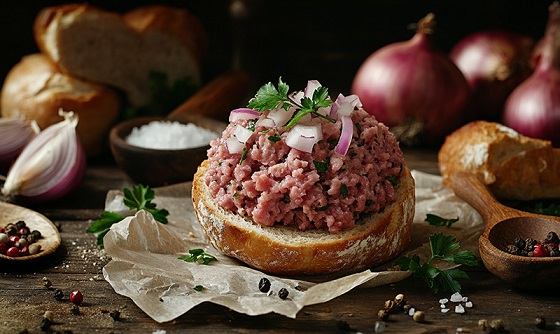
To the untrained eye – and especially the non-German stomach – Mettbrötchen might look like a culinary dare. Raw minced pork spread on a crusty bread roll, topped with raw onions, salt, and pepper? In many cultures, this would be a serious food safety concern. But in Germany, it’s a beloved breakfast item, a snack sold in bakeries and butcher shops, and a staple of everyday life in regions like Lower Saxony and North Rhine-Westphalia.
So what makes this raw pork sandwich not only acceptable but cherished? In this article, we’ll break down the real story of Mettbrötchen – where it comes from, how it’s made, why it’s safe (when done properly), and what it says about German culinary culture.
What Is a Mettbrötchen?
At its simplest, a Mettbrötchen is a crusty bread roll topped with seasoned raw minced pork (Mett) and finely chopped onions. It’s usually seasoned with salt and pepper, and often served cold, freshly prepared by the butcher or baker.
Mett, the star ingredient, is a type of finely minced pork made from pork shoulder or neck, with a high-fat content that keeps it moist and flavorful. It’s often served on a Kaiser roll or rustic German Brötchen.
In Germany, it’s common to see Mettbrötchen offered in delis, at office breakfast buffets, or even during social gatherings. Its freshness and quality are key to its widespread acceptance.
The Cultural Roots of Mettbrötchen
A Butcher’s Specialty
The tradition of eating raw pork in Germany goes back centuries. Mett itself is a regional term, derived from the Old Saxon meti, meaning minced meat. In many parts of Germany, raw pork was considered a delicacy, particularly when sourced from local butchers who knew their farmers and handled the meat under strict hygiene standards.
The idea of pairing it with bread likely emerged as an affordable and protein-rich snack for workers. As cities industrialized in the late 19th and early 20th centuries, Mettbrötchen became a staple at butcher counters, often enjoyed mid-morning or as a quick lunch.
Regional Popularity
Mettbrötchen is especially common in Northern and Central Germany, including areas like Hanover, Brunswick, and the Ruhrgebiet. While some parts of Germany might favor cooked sausages or spreads, in these regions, raw pork is not only accepted but expected.
Cultural expressions like the “Mettigel” – a mound of seasoned Mett shaped like a hedgehog with onion spikes – show how deep the affection for this dish goes. It’s served at parties, buffets, and office celebrations with a sense of humor and pride.
Is It Safe to Eat Raw Pork?
The number one question most non-Germans ask is: Can you really eat raw pork safely? The answer is yes – if and only if certain conditions are met.
Strict Hygiene Regulations
In Germany, meat used for Mettbrötchen is governed by rigorous food safety laws. Raw pork intended for consumption must be:
- Ground fresh daily
- Free of parasites and pathogens
- Kept refrigerated until served
- Purchased from certified butchers
The official term is Schweinehackfleisch zum Rohverzehr – pork mince approved for raw consumption. It’s illegal to serve raw pork in Germany that doesn’t meet these safety standards.
For safety-related discussions, you can read more in the article: Is Mettbrötchen Safe to Eat?
Why It Works in Germany
Germany’s food inspection system, combined with a culture of trusting local butchers and same-day preparation, makes Mettbrötchen reasonably safe. Outside of Germany, however, it’s usually advised not to replicate the dish unless you have access to equivalent meat quality and preparation standards.
The Taste and Texture of Mettbrötchen
To those who’ve never tried it, raw pork might sound odd – but Mettbrötchen offers a unique texture and flavor experience:
- Texture: Soft, smooth, almost spread-like
- Flavor: Mild, slightly sweet from the pork, punctuated by sharp raw onion and salt
- Mouthfeel: Balanced by the crunch of the roll and the bite of pepper
Its simplicity allows the quality of the ingredients to shine. A fresh Mettbrötchen is not greasy or overpowering – it’s clean, satisfying, and surprisingly delicate.
Modern Perception: Beloved or Bizarre?
Germans Love It
In Germany, Mettbrötchen is no novelty. It’s as unremarkable – and as essential – as a peanut butter sandwich in America or a jam-and-toast breakfast in Britain. For many, it evokes childhood memories, office breakfasts, or quick stops at the butcher on the way to work.
Outsider Curiosity and Internet Fame
Online, however, Mettbrötchen has taken on a second life as “the raw pork sandwich” that baffles the rest of the world. It has become a favorite topic for food bloggers and YouTube reaction videos. Some embrace it; others recoil in horror.
This divide only reinforces its status as a uniquely German cultural artifact – one that defies international food norms while staying proudly rooted in local tradition.
Where to Find or Try Mettbrötchen
If you’re visiting Germany and want to try an authentic Mettbrötchen, the best places are:
- Traditional butcher shops (Metzgerei) in Northern or Central Germany
- Bakery counters that prepare fresh breakfast snacks
- Hotel breakfast buffets or morning markets
Always ask whether the Mett is freshly made and approved for raw consumption.
Fun Facts About Mettbrötchen
- Mett Monday: Some German office cultures observe Mettwoch (a play on Mittwoch, or Wednesday) or Monday morning Mettbrötchen traditions.
- Decorative Mett: At parties, Mett is sometimes shaped into animals (especially hedgehogs), complete with onion eyes and spines.
- Spices Vary: While salt and pepper are standard, some regions add paprika, caraway, or nutmeg to their Mett.
Mettbrötchen may be unfamiliar or even shocking to non-Germans, but for millions in Germany, it’s a simple pleasure with deep roots in culture, history, and daily life. Made fresh, served cold, and eaten with confidence, it represents the intersection of tradition, trust in craftsmanship, and a no-frills approach to great food.
Curious to go further? Explore our related articles on German Salad Recipes, Frühstück – Traditional German Breakfast, and our full German Recipes Collection for more insight into what makes German cuisine so uniquely bold.
Related Articles
Mettbrötchen – Traditional German Recipe
Learn how to make authentic Mettbrötchen at home with this step-by-step guide, including ingredients, safety tips, and serving suggestions.
Is Mettbrötchen Safe to Eat?
Worried about eating raw pork? This article explains why Mettbrötchen is safe in Germany – and what precautions matter most.
The Cultural History of Mettbrötchen
From butcher counters to breakfast tables, explore how this raw pork sandwich became a symbol of German culinary tradition.
What’s in a Mettbrötchen? Ingredients and Regional Tips
Find out what really goes into a Mettbrötchen, including ingredient choices, regional variations, and modern serving ideas.
Mett vs. Hackepeter: What’s the Difference?
Understand the key differences between Mett and Hackepeter – two raw pork dishes with unique flavors and regional identities.
Why This Raw Pork Sandwich Terrifies Americans (But Germans Love It)
Explore the cultural divide between Germany and the U.S. over Mettbrötchen – a dish celebrated in one country and feared in another.
10 Surprising Facts About Mettbrötchen
Think you know Mettbrötchen? These fun facts reveal hidden quirks, surprising history, and what makes this dish a German classic.







